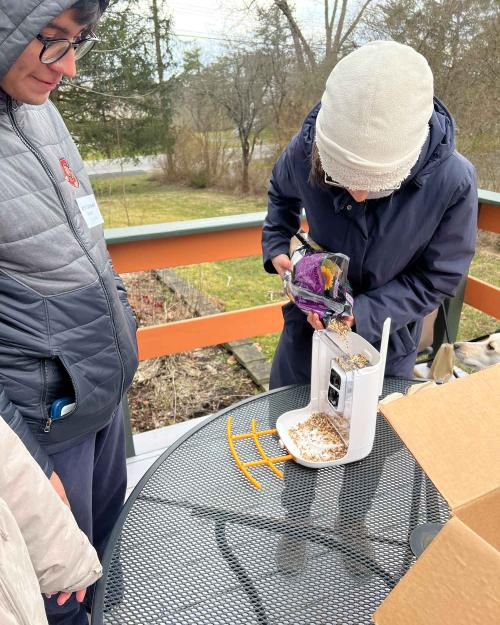This past spring, Precious Oyewole ’24 explored birds and bird communication with her “birding buddy” – a student at the Tompkins-Seneca-Tioga Board of Cooperative Educational Services (BOCES).
The pair were part of a group of nine Cornell students and nine high school students with disabilities or communication challenges in the BOCES Career Program who met for 12 weeks as part of the A BIRDSONG Program.
At the end of the semester, Oyewole and her partner combined their new bird knowledge with the partner’s love of dinosaurs to create their final project.
“Creating this engaging lesson plan was particularly rewarding, because of how happy and proud she was to help create something that allowed her to share her passion with the entire class,” Oyewole said. “Participating in the BIRDSONG Program has been a transformative experience, allowing me to strengthen my ability to communicate scientific concepts effectively to individuals with differing abilities.”
BIRDSONG (Building Inclusive Research and Designing Supportive Outreach and Networking for Growing talents) is a collaboration between the Cornell Lab of Ornithology, BOCES and Cornell students. The community-engaged outreach program is the brainchild of Nora Prior, assistant professor of psychology in the College of Arts and Sciences, and was funded in part by the Einhorn Center for Community Engagement, through their Engaged Opportunity Grant program.
Prior and her lab members will be running the project again this academic year, in both the fall and spring semesters, and students can earn independent research credit. Interested students can find an application on the program’s website.
Prior’s research focuses on complex communication in birds and how birds use songs and calls to impart information and form social bonds and relationships. She’s also very interested in the diverse ways that animals – and humans – perceive communication and social interactions, whether they be auditory, visual or using other senses.
“There’s a lot of social and perceptual diversity in the animals we study and in humans as well,” she said. “We’ve started to realize that birds are hearing their vocalizations differently than we do, and that there is more individual variation in bird song and in calls than we previously thought.”
Community of birders
Prior thought these variations offered the perfect platform to create a community of people with varied communication abilities who all share a common interest – in this case, birds.
“People can understand their own challenges with communication in the context of the bigger wider world when they learn about the variety in bird song,” said Mya Thompson, co-director of engagement in science and nature at the Lab of Ornithology. “Birds are not just wind-up toys that always sound the same, but are creatures communicating, sending messages to a listener.”
The ”birding buddies” took bird walks at BOCES, played games to learn about bird songs, used spectrograms to explore visual representations of sound, made bird feeders and visited an osprey nest in Stewart Park.
“The joy and the beauty of birds, particularly around song, for many people is a source of solace and beauty,” Thompson said. “If you play bird songs for people of any age, any cognitive ability, it can be really special.”
Karen Bennett, special education career skills teacher at BOCES, said the goal for her students was to gain flexible communication skills.
“For our students, sometimes their confidence level isn’t high. But programs like this one get them outside of their school and working with different people,” she said. “They realize they can talk well with other people and they’re learning those social skills.”
After the program ended, Bennett noticed that many of the students had gained some birding skills.
“I would take them on field trips and hikes,” she said, “and now they’re noticing all of these birds that they had learned about.”
For the Cornell students, many of whom are interested in science communication, Prior stressed the importance of considering all members of your potential audience and being flexible communicators when designing educational programs and activities. “We should be able to put out inclusive content without knowing all of our members’ communications challenges,” she said.
Each birding pair developed a project they shared at the final meeting, ranging from a printed “restaurant menu” for birds, based on what different species eat, to games to test bird knowledge.
Prior said projects like this also expand her own research.
“The more you can be inspired by diversity and be curious and open-minded, the more interesting questions you will ask in the lab,” she said. “That’s how we move science forward.”






